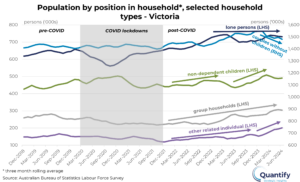Understanding trends in household formation is important to understanding how population growth translates to housing occupancy and new dwelling demand.
The COVID-lockdown period and immediate aftermath saw big changes in living situations in Victoria that are now steadily unwinding.
- Growth in the population living in group households, as related individuals (typically siblings), and as non-dependent children (adult children in the family home) began at the end of lockdowns in 2021 but has accelerated over the past 18 months or so.
- Meanwhile, the growth in lone person households that began during the pandemic lockdowns appears to have plateaued since the end of 2022.
- Population in couple without children households also showed a similar rising trend, but is decreasing in 2024 – potentially reflecting the increase in adult children in the family home.
The fall in average household sizes that occurred through the COVID pandemic is now reversing. Quantify Strategic Insights estimates the net effect is that annual household formation in Victoria has reduced by around one third, from a peak of just over 90,000 additional households in the year to April 2023, to around 60,000 in the year to June 2024. This compares with the 55,000 or so dwellings completed in Victoria in FY2024.
The market is doing what markets do. Rising rents and prices due to the imbalance between demand and supply is rationing demand. Any immediate uptick in supply is unlikely, while the jury is also out on the rate at which population growth will slow and reduce demand. ‘Economics 101’, therefore, suggests that household formation will be further constrained, with rents only stabilising when they reach a ‘market clearing’ level that balances demand and supply. The question is how much further household structure in Victoria will change before rents stabilise?
From a policy perspective, the key challenge is to balance flexibility with foresight in responding to both market-driven changes in household behaviour and long-term population growth. As a starting point, monitoring trends in household composition is vital if policy is to enable delivery of the number, and type of housing required, and to ensure that changes in household formation are accounted for.
For more analysis on trends in demographic change and impacts on the housing market, contact Rob Burgess or Angie Zigomanis.


